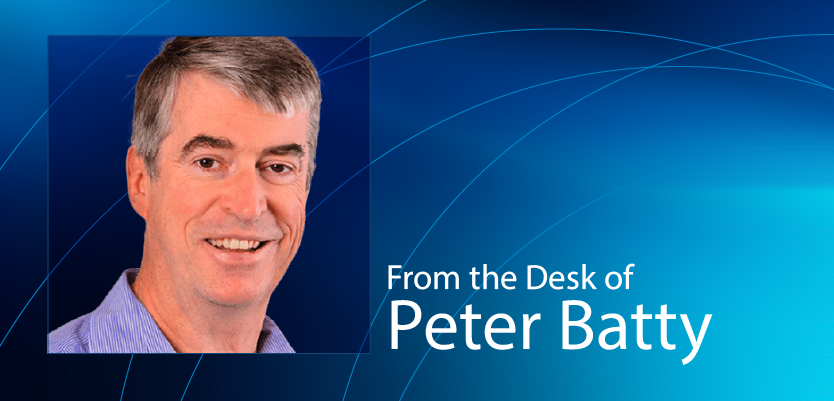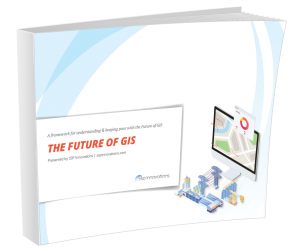As you may have seen, I recently joined SSP in the newly created role of Chief Research Officer, and I’m excited to be here. In this blog post, I’ll explain a bit about my background, why I joined SSP, what I’ll be working on and how I see the current GIS market.
My background
I’ve worked on developing GIS for utilities and telecoms for the past 35 years, with a couple of short detours along the way. I’ve been CTO of GE Smallworld, Intergraph, and IQGeo.
I’ve created multiple products from the very beginning, including IQGeo’s myWorld platform and GE’s electric outage management system, PowerOn, and I worked on Smallworld from pretty early days, joining when they had around 30 people and was the first person to move to the US when Smallworld started over here in 1993.
So I’ve worked with a wide range of platforms, but not much with Esri up to this point – though I did have a couple of years of being part-time in the Esri ecosystem previously, working in an advisory role with Aaron Patterson and Adam Tonkin at Enspiria in 2008-2009.
I’ve also worked with companies at all stages of their evolution, from doing multiple startups to being CTO of three public companies, as well as being an employee at mega-corporations like IBM and GE. With the breadth of my experience, I hope I can help SSP in various ways as we continue on an exciting growth path.
Why did I move?
Several people have been surprised about me joining SSP because for the great majority of my career I’ve worked for Esri competitors, and I’ve often been the main voice of those companies pitching their stories against Esri. I was at IBM in the 1980s, Smallworld in the 1990s, Intergraph in the 2000s, and IQGeo (formerly Ubisense) in the 2010s.
So, I just wanted to say a few things about switching companies, which I think should be somewhat obvious but are still worth saying. This will be the fourth time that I’ve switched to working on a new platform, each of which was competitive with my previous company. All of the companies I’ve worked at have had good products, good people, and have done a good job for their customers. All of the products, and companies, have their own strengths and weaknesses relative to the others. There are always some mixed feelings when you move on, leaving behind friends who may be disappointed you are joining a new team. But there’s an excitement about doing new and different things in the new environment.
Obviously, It was a big decision for me to leave IQGeo, as I was one of the founders there, and there were quite a lot of factors that I weighed in deciding to move.
Overall though, the biggest factor in my decision was my belief that there is a huge opportunity to transform how we capture and maintain data with a combination of new technologies including computer vision, machine learning, and augmented reality. At the moment, we’re calling the particular area I want to focus on Automated Field Sourcing, though we’re thinking about alternative terms – if you have any naming suggestions let me know!
I feel the time is really right to do this now, and that there’s a great opportunity to have a transformational impact on the industry. I think we will see a more fundamental change in the next 5 years than in the previous 35 that I’ve spent in the industry. I weighed three options for approaching this – do it at IQGeo, start a new company, or do it within another established company. To cut a long story short, I decided that SSP was the best option. Key factors were their willingness and ability to invest in new ideas, the great team here, having excellent access to the market with a great customer base, and the dominant position that Esri has in the utility and telecom marketplace.
So I’ll be working on researching technology and building out new products in this area. In addition, I will also be supporting the team in the existing business – I’ll be working closely with our CTO Adam Tonkin, and the presidents of the two lines of business, Aaron Patterson on the utility side and Dustin Sutton on the telecom side.
Automated Field Sourcing
Let me explain a little more about Automated Field Sourcing. I think the biggest unsolved problem in regard to geospatial technology in infrastructure companies is handling as-built updates. More or less all the companies I talk to have as-built update backlogs that are weeks if not months.
There’s a lot of talk in the industry about digital twins. This has been a major theme for both Esri and SSP, and a lot of the drivers for the Esri Utility Network are around creating a digital twin – to be able to handle the data modeling, visualization, analysis, and so on of a very detailed digital model, or twin, of your network. But to me, a key missing element is ensuring that this digital twin is always up to date. Even with today’s advances in mobile apps, having workers sketch information about what they’ve done is just too complex and time-consuming to fully address the problem of immediately getting as-built changes back into your system. That’s where these new technologies have huge potential to deliver a much simpler and more automated way of capturing data about infrastructure in the field. I spoke a bit more about this in the opening session of our iLLUMINATE conference recently, and will be doing a more detailed presentation on the topic on July 15th, so please check that out – we’re actively working on a prototype and will have some exciting capabilities to show!
Perspectives on the current GIS market
Fairly recently, there was an IQGeo blog post in which I was critical of the Esri Utility Network, and several people have asked me why I moved to SSP if that was how I felt? Firstly, I should say that I wrote and published that post 18 months ago. IQGeo just happened to republish it again recently – and many things have changed in those 18 months. Secondly, obviously, I was writing that post from an IQGeo perspective and articulating the arguments in favor of their solution – it wasn’t an unbiased evaluation from a third party.
I’ll discuss the main points I made in that article from my current perspective as an SSP employee, 18 months down the road.
I said that moving to the Utility Network was complex and costly, and I would still say that’s true in general, but it’s also true that implementing any new enterprise GIS platform in large utilities and communications companies is inherently complex and costly. An important point here is that it’s a great credit to Esri that they are the only one of the three main established vendors in the space to have built a new platform to replace their previous one: the Smallworld product is 30 years old and Intergraph is 25. While both of those are good products, having product architectures that old comes with some significant issues – I don’t see either of those really being viable options for someone implementing a new system today. Also, I would add that SSP working together with Esri has done a lot over the past couple of years to reduce the complexity and cost of moving to utility network, and we are continuing to work on this as we make the utility network available to the entire market including mid and smaller sized utilities.
I also said that the new network modeling capabilities in the Utility Network are similar to capabilities that Smallworld and Intergraph had 20+ years ago. I still think that is true. But I think this is a bit of an academic point now, as their architectures are so old, as I just talked about. The Utility Network model clearly moves a long way forward from the previous Esri model, the geometric network, and provides the basis for implementing a much more comprehensive digital twin than before, on top of a modern services-based software architecture.
I discussed a couple of IQGeo’s key strengths, usability, and mobility. Those continue to be strengths for IQGeo, as they have always been, and I think that IQGeo was successful in raising the profile of these requirements in the market. But IQGeo’s competition has taken note of that and hasn’t been standing still.
I did my first review of SSP’s MIMS mobile product the other week and was very impressed. A couple of years ago it was primarily a Windows-based product, together with a separate iOS app with quite simple functionality. It has gone through some significant re-architecture and redesign since then. It has an entirely new user interface, which is simple and reminiscent of consumer apps like Google Maps – an approach I have been advocating for a long time. And it now has a cross-platform architecture, with one code base providing identical functionality across iOS, Android, and Windows devices using the Xamarin development platform. Its offline data sync architecture is very robust and scalable. It also provides some significant advantages for Esri customers through using the ArcGIS Runtime platform – like the ability to display vector data with styles that exactly match the desktop GIS, which has various benefits including reducing the size of offline databases and simplifying the sync process. MIMS also has extensive configuration capabilities which drastically reduces a customer’s need to add customization.
I won’t get into specific comparisons, but I will say that I think that the latest MIMS mobile application is a very compelling choice for Esri utility customers, with excellent usability, robust and scalable offline sync capability, great configurability, and all on the native Esri platform.
Lastly, one thing that I didn’t talk about in that blog post is timing. There is major momentum in the utility GIS market at the moment to migrate to the Esri Utility Network, both from existing Esri customers and from other established platforms like Smallworld and Intergraph. Any utility that has just done a GIS migration is not going to change platforms for another 10-20 years. And any utility that has started on a migration project is very unlikely to choose a different direction.
Any company launching a new system of record product into this market needs to battle the fact that utilities are very conservative – there are very few who would consider being the first (or second, or third) utility to adopt a major new enterprise product. Given that it will typically take 2-3 years to replace an existing large enterprise GIS and get a new system in production, there’s a significant lag from when you sell your first few customers to when you have production references, which is where you need to get to in order to have the huge majority of the market even consider you as viable. I’ll let you do your own evaluation as to where any potential new players might currently be on that adoption curve and, of note, you may have heard Matt Piper talk about the adoption curve of SSP and the Esri utility network in the SSP iLLUMINATE plenary.
Overall, the momentum in the market continues to be very much in Esri’s favor. The other well-established GIS players have 20-30 year-old products and show no signs of embarking on the development of new platforms. The much-improved network modeling in the utility network addresses what was arguably Esri’s main weakness against those traditional competitors. And the conservative nature of the market is a formidable barrier to new contenders. I think that Esri will further increase its already dominant market share over the next few years and I look forward to working within the Esri ecosystem on the potentially game-changing ideas that I talked about above. We have an exciting road ahead!


What do you think?